Oct 06 2010
Grapes Abound: Pollo y Vino
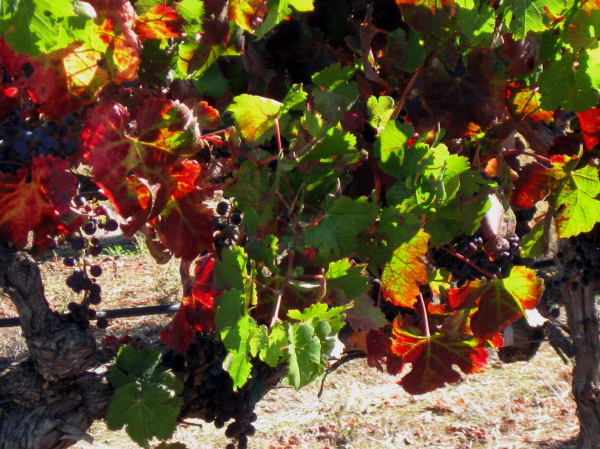
Every so often I like to feature a food and wine pairing that dispels the traditional safe notions that (i) white wine pairs with poultry and fish and (ii) red wine pairs best with red meat and pork. While in many circumstances the traditional rule is best followed, a vast creative world awaits your departure thereof. In reality, the method of preparation (as opposed to the protein) will determine the dish’s versatility for pairing with various wines. In the past week I caught myself in two separate instances having a conversation about chemistry being the foundation of recipes: depending on the ingredients used, the dish’s acidity or the sugar content can be affected greatly and change the protein’s identity in the meal. Chemistry similarly carries over to wine as the pH level largely dictates a wine’s food pairing capability. Certain varietals are more acidic than others, with such designation not sitting solely with white wines. Red wines can also be acidic (for example, Barbera, Charbono and Aglianico) but I have found that aside from the varietal itself, this can also stem from the age of the grape vine or the soil where the vine is planted.
Stagecoach Vineyard, located 1200 feet above Oakville and below Atlas Peak, is a relatively young vineyard in that it was started in 1995 by the Krupp Family and if you find yourself touring around by car you will feel as if you are in a set almost out of an old Western movie. The vineyard’s location is dry with bright and seemingly never-ending sunshine, complete with sagebrush vegetation. Beneath the top of the soil sits a rocky and volcanic terroir which completes the image of desolate dryness yet will cause any wine aficionado to salivate with anticipation. The vineyard itself is the largest contiguous mountain planting in Napa Valley and the Krupp Family grows grapes for over 40 renowned vineyards. If association by vintner is not enough, the vineyard also saddles up to the southern side of Pritchard Hill (which is well-regarded for its grapes).
Taking into account the vineyard’s date of existence and its soil, it will not surprise the palate that red wine varietal grapes grown at the Stagecoach Vineyard are going to boast bright, fresh acidity. Knowing this in advance will help prepare the palate for the flavors that ensue and how to best pair these wines with food.
Robert Biale Vineyards (“Biale”), long known for its prowess in all things Zinfandel, values this site enough to have its own block (the “Biale Block”) tucked into this vineyard such that it looks out over the entire Napa Valley from Carneros to Calistoga. Looking down on Oakville, the Biale Block consists of plantings of old Biale clones on old fashioned St. George rootstock. Biale likes to hold this out as “the most serious work in the modern era to keep the legacy of Napa Zinfandel going strong” and with a taste of Biale’s 2007 Stagecoach Vineyard Zinfandel (Biale Block) the winery’s confidence is clearly understood.
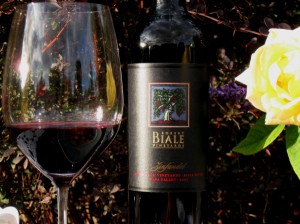
Despite the relative youth of the vines, the wine barrels through the mouth with undeniable presence and sophistication. The acidity is bright and welcoming for a Zinfandel and perhaps the most distinguishing feature of this wine is the unique yet readily recognizable pomegranate nose. The nose, ladled with pomegranate is followed by a wisp of the aroma of cranberry sauce and the palate presents refreshing flavors of raspberry, gentle white pepper, minerality and toffee.
Given the distinct acidity and bright red fruit found in this wine, the food pairing will need something that can match the acidity yet not overpower the aromas and flavors found therein. Taking this into consideration, this week’s menu creatively boasts:
· Slow Roasted Pollo a la Uva Atop Sautéed Zucchini and Caramelized Onion
Far more often than not, when I have been visiting a winery, I have been asked, “What wine pairs with Mexican food?” The answer is just as long and detailed as such a question so vaguely framed merits. Mexican food is defined and comprehended by people so differently, as well as it should. Mexico, just like the United States, has its various regional culinary styles (not including the United States’ interpretation of “Mexican fare”). Much of my time living abroad was spent in Central Mexico and Mexico City. The cuisine of Central Mexico has held a soft spot in my heart as its flavors can be as delicate, layered, sweet and poetic as sophisticated cuisine of Europe. Fittingly, this week’s recipe “Pollo a la Uva” (meaning Chicken with Grapes) reflects this style of cooking and has its origins in Aguascalientes, Mexico, which is located in the center of Mexico and is often referred to as “el Corazon” (the heart) of the country.
Of unique importance, this recipe does not contain a single chile pepper, cilantro, cumin or other hot spice. Instead it yields sweet tomatoes (which are known for their acidity), celery, herbs, garlic, onion, wine, chicken (of course) and grapes. Grapes? Yes, grapes. Grapes thrive in the area where Aguascalientes sits.
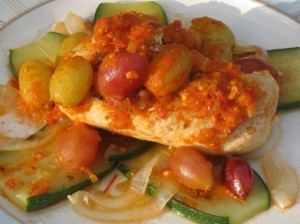
Originally in the colonial period, Spanish settlers brought over a Spanish vine to be grafted onto the indigenous Mission vine. As grape growing took off, Spanish authorities began to fear that the wine produced in this area would compete with Spanish wines which were being imported to the New World and by 1771 banned the production of not only grapes but olives, too. At that point, anyone found growing vines or olive trees would suffer heavy penalities. Fortunately much later in time, the grape industry and wineries were revitalized in Mexico and grapes can have an appropriate place in cuisine.
The chicken itself is first brined in white wine and ultimately slowly cooked in a medley of heirloom tomatoes from the garden, white onion, celery, garlic and herbs. Both thyme and marjoram thrive in my garden and while I have a rather constant culinary love affair with the thyme plant, the presently thriving marjoram has captivated my fickle senses with its gorgeous perfumed aromatics. Given the delicate balance of flavors in this dish, I cannot imagine using anything but fresh herbs to give the dish the proper personality. Once the chicken has been slowly roasted in the oven, the vegetables are blended to create a sauce akin to the sophistication of those found in French cooking. With the addition of wine and ultimately grapes towards the end of simmering, the sauce ultimately takes on a bright, slightly sweet sophisticated flavor that can only be attributed to Central Mexican cuisine. The kitchen smells like a first class restaurant and my guests are salivating in the living room.
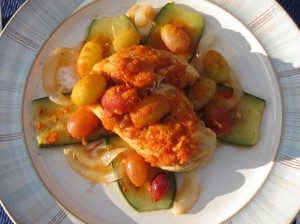
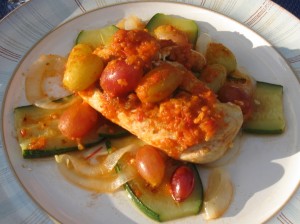
To plate the meal, thinly sliced strips of garden fresh zucchini are gently sautéed in a spritz of roasted garlic olive oil and thin slices of onion are caramelized in the same covered pan.
Pairing with the wine is a spectacular display of the versatility of a Zinfandel with poultry. The acidity of the tomatoes and the grapes each combine to create a soft sweetness that seemingly magically dispels the acidity found in this bright Biale Stagecoach Vineyard Zinfandel and instead allows the lovely fresh flavors of pomegranate and raspberry in the wine to shine through. While young, the wine’s spices add depth and the gentle notes of white pepper also ensure that the pairing with the food is balanced.
While celery is added to this recipe it is sparingly used such that it just gives a subtle layer of depth and flavor such that my guests could not quite determine what was included in my recipe. The heated grapes burst with a unique sweetness that impressed even the most discerning palate sitting at my table this week. Given that wine is included in the sauce and brined the chicken, at times it renders a flavor in the dish almost akin to a rosy plum sauce. The zucchini used to plate the dish was included not only for color but for its subtle earthy vegetal flavor which pairs well with lingering herbal notes found in the wine.
In the end, while finishing the wine in the glass, I stole to the pantry to produce some simple baked oatmeal cookies. While not shown here, the baking spices in the simplicity of a plain oatmeal cookie accentuate the toffee, vanilla and spice of the wine, rendering it as the perfect simple palate cleanser after a meal well done.
As warm autumn afternoons meet the cool breeze of early evening and for as long as grapes abound, Pollo a la Uva will be on my culinary calendar each October long before my palate begins to crave the heavier dishes of winter.
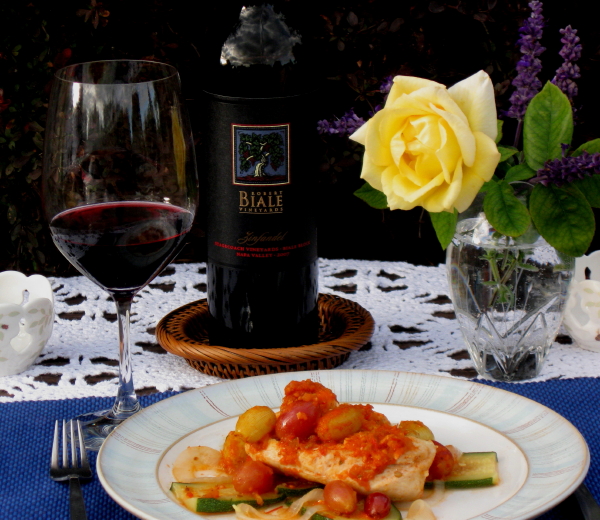
Comments Off on Grapes Abound: Pollo y Vino